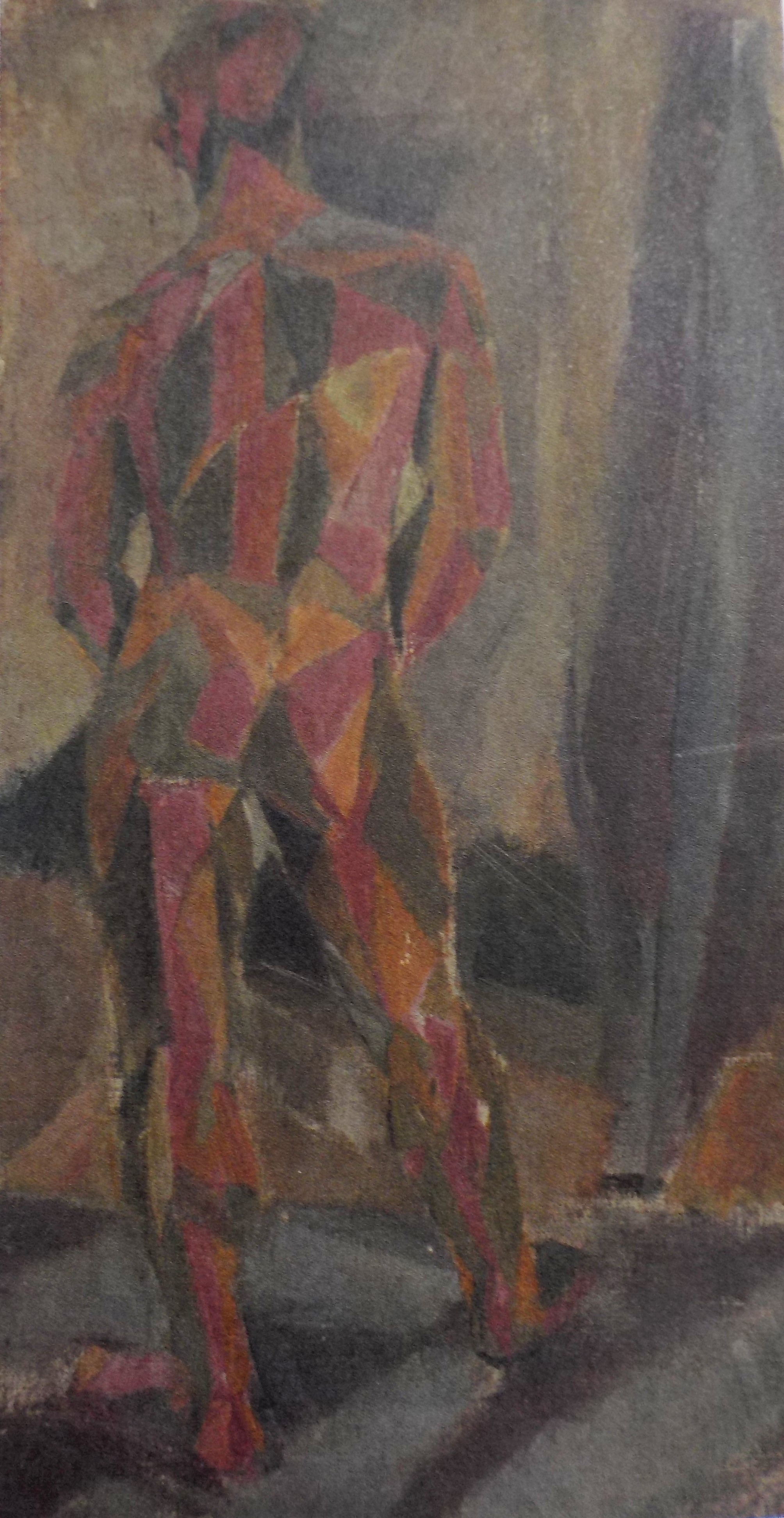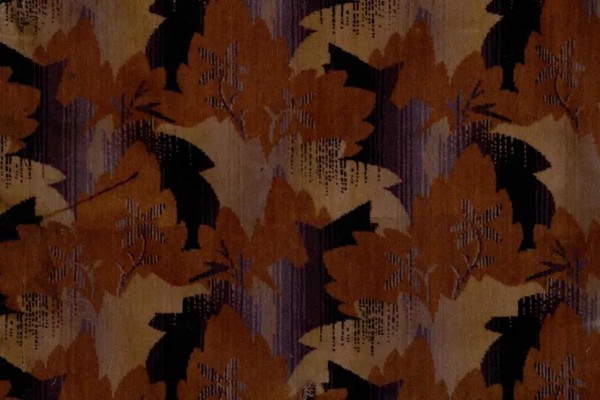
Enid Crystal Dorothy Marx, RDI, 20 October 1902 – 18 May 1998.
Enid Marx was born in London to Robert Joseph Marx and Annie Marie Neuberger, the youngest of three children. She was known familiarly throughout her life as “Marco” and was also a distant cousin of Karl Marx.
Her artistic inclinations were fostered from an early age, especially by her older sister Marguerite who lived in France for a period. Enid found pleasure as a young girl in collecting samples of ribbon from textile shops. She travelled with her family in Europe before the First World War witnessing the Avant-garde arts movements of the early 20th century.
Marx first attended South Hampstead High School, after which her parents transferred her to Rodean School for girls, Brighton from 1916 until 1921. Her artistic studies there included life drawing, printing, and carpentry.
She studied at the Central school of Arts and Crafts for a year studying drawing, pottery and design for printed textiles under Bernard Adeney.
Marx moved to the painting school at the Royal College of Art (RCA) in 1922. Her classmates there included Edward Bawden, Eric Ravilious, Barbara Hepworth and Barnett Freedman.
‘I went into the Painting School, it was really unacceptable to be in any other, and drawing was so important to me. Sir Frank Short wouldn’t have me in his wood engraving class: he said I drew so badly and wasn’t worth teaching. But Eric Ravilious sneaked me in after hours and taught me what he had learned that day!’
She later recalled: ‘The Sussex Downs were another love we had in common. Sussex was Rav’s home county. I was a Londoner but had spent many years of my childhood amongst the Downs, with which I feel I had an affinity.’




Wood engravings: Back Garden and Abstract Pattern 1925. These are two of the wood engravings completed after Marx’s exclusion from Frank Short’s classes! The Downs Above Plumpton, pen, wash and watercolour, 1924. Male Nude, 1924.
Douglas Percy Bliss headed the college magazine Gallimaufry with woodcuts by Eric Ravilious and Marx and caricatures by Edward Bawden. This was followed by another version of the college magazine – ‘Mandrake’.

As a student, Marx was influenced by Paul Nash, then a tutor at the RCA, who introduced her to publishers and encouraged her avant-garde leanings. Her woodcuts published in Gallimaufry, must have seriously irritated Sir Frank. At her final assessment in 1925 Marx was failed by Claude Ricketts, she left the school that year. Marx insisted on drawing in an abstract manner refusing to draw ‘the washed-out William Morris stuff required of her.’ Her work was judged to be “vulgar”, reflecting her interest in popular forms and rejection of the traditional definition of fine arts. Nearly sixty years later, in 1982, the College awarded her an honorary degree.
In 1925, after leaving the RCA before Marx went to work for the textile designers Phyllis Barron and Dorothy Larcher at their studio in Hampstead. Marx learnt how to mix vegetable dyes as well as the steaming, ironing and working of printed fabrics. She became a member of the Society of Wood Engravers in 1925.
In 1927 she started her own workshop over a cowshed on Hampstead Hill where she designed and produced block-printed textiles, often making use of naturally derived dyes instead of new chemical methods. Her work was sold through the Little Gallery, off Sloane Street, and later at Cecilia Dunbar Kilburn’s Dunbar Hay gallery.
Marx experienced tragedy in her life when in 1928 her sister Daisy was taken ill returning to London from Paris dying aged only thirty-seven. Soon after this Marx moved her home and studio to Ordnance Road, St John’s Wood.
In 1929 Marx designed her first commercial book cover, for a monograph on the engravings of Albrecht Dürer. She created patterned papers for the Curwen Press and received commissions from publishers Chatto and Windus.
Since childhood Marx had loved popular art, a passion shared with her friend and lifelong companion, Margaret Lambert, a historian of 20th-century European politics, whom Marx had met in the early 1930s. From the late 1930s Marx and Lambert began collecting popular ephemera, such as scrapbooks, valentines, paper peepshows, children’s books, Staffordshire dog figurines and toys. They used their collection as the basis for a book entitled When Victoria Began to Reign, published by Faber and Faber in 1937. Lambert and Marx co-authored English Popular and Traditional Art in England (1946), which they expanded into English Popular Art (1951).

Marx taught a Wednesday design and engraving class at the Ruskin School of Art at Oxford, with colleagues Barnett Freedman, Eric Ravilious and Paul Nash, until 1936.
In 1937 she was selected by the London Passenger Transport Board to design the moquette seat fabrics for use on the seats of London buses and tube trains. The new seat fabrics were part of a customer-experience cantered redesign, spearheaded by Christian Barman and Frank Pick, focusing on interior fabrics and surfaces. Marx was advised that the material had to ‘look fresh at all times, even after bricklayers had sat on it’, as well as not being too dazzling as it was destined for moving vehicles. The first three fabrics she designed – called ‘Belsize’, ‘Bushey’ and ‘Brent’ – combined her characteristic use of pattern with a modern feel in keeping with LT’s wider approach to design.
Marx later recalled in a lecture to other textile designers that ‘We all thought at first that the best way of disguising dirt was to use colours which would more or less tone in with the dirt’ but that ‘the best method of ensuring the seats would look clean after a period of use was to use strongly contrasting tones and rather brilliant colour’.





Designs for London Passenger Transport Board, moquette seat fabrics.
Ravilious visited Marx at her St John’s studio making a large-scale pencil sketch of her working environment with colour notations. Enid’s harvest decorated mugs provided the stimulus which led to Ravilious’ Persephone (Also known as Harvest Festival) design for Wedgwood.
During the Second World War, she began writing and illustrating her own small format children’s books, including Bulgy the Barrage Balloon (1941) and The Pigeon Ace.



During World War II, she was commissioned by The Pilgrim Trust to paint 14 watercolours of buildings under threat from bombing for its “Recording Britain” project.




Four of Enid’s Recording Britain paintings: Houses in Marlborough Hill, St. John’s Wood. The Knights of St Johns Tavern, Queen’s Terrace, St John’s Wood. No.1, Cornwall Terrace, Regent’s Park. Almshouses, St John’s Wood. All 1940.
Recording Britain was an artistic documentary project sponsored by the British government in the late 1930s as the country faced the potentially devastating impact of a second world war. The resulting collection of more than 1,500 watercolours and drawings, by both well-known and amateur artists, is a rich visual record of buildings, landscapes, and livelihoods perceived to be under threat.
In 1943, the furniture designer Gordon Russell invited her to become a member of the Board of Trade Utility furniture Design Advisory Panel, which was tasked with implementing wartime austerity standards in the field of interior and furniture design. She became responsible for its range of textiles, eventually creating over 30 commissioned designs. The textile patterns were primarily geometric, although Marx also introduced some floral motifs after seeking feedback from her charwoman.
In 1944, Marx was elected to the Faculty of Royal Designers for Industry, reflecting her ability in practical industrial design and the respect of her peers. Marx was commissioned to design more moquettes for LT, with ‘Shield’ perhaps her best known and liveliest design. It was used on refurbished 1938 Tube stock trains in the late 1940s, using the same colours as ‘Chevron’ but breaking away from the straight lines of her previous LT patterns.

The ‘Chevron’ design is a geometric pattern consisting of a light green grid overlaid by diagonal red stripes and checks in the form of a ‘chevron’, on a dark green background. Designed by Enid Marx in 1938, this moquette was used to re-upholster seats on 1938 Surface Stock trains. On vehicles for the Piccadilly and Central lines it was teamed with red leather arm rests.
Marx was awarded the distinguished status of Royal Designer for Industry by the British Royal Society of Arts in 1944. Marx was one of the designers chosen to exhibit in the Royal Pavilion at the Festival of Britain in 1951.
After the war Marx designed covers for Penguin Books. She finished an engraving series called Marco’s Animal Alphabet in 1979, although it was not published until after her death.



Marx considered several teaching positions after the war at the Central School of Arts and Crafts and the RCA, before eventually getting hired in 1947 at Gravesend School of Art, teaching creative design for fabric printing. In 1949 she took an interior decoration lecturer position at the London County Council City Literary Institute in Covent Garden. Between 1951 and 1955 Marx taught design at Maidstone College of Art in Kent and between 1955 and 1957 she taught embroidery (design) at Bromley College of Art. Marx was appointed head of Textiles, Dress and Ceramics at Croydon College of Art in 1960 and in 1965, she retired from her full-time position to become a guest lecturer in textile history.
She was commissioned by LT to design posters in 1957 that exhibited her skills as a printmaker.



Marx designed the frame around the portrait of Queen Elizabeth II on the British Wilding series of penny, halfpenny, and three-halfpenny stamps, and the 1976 Christmas stamp issue featuring medieval embroidery.

Top row: one of Marx’s designs for the Wilding Series
of low-value stamps. The red stamps in the bottom row are a design by Michael Farrar-Bell.
During the late 1950s and 1960s, Marx lived with her partner Margaret Lambert in St Andrews, Scotland. In 1956 Lambert was appointed as Lecturer in Modern (European) History at St Andrews University having first been considered for a post at Cambridge where she had advised on an extra-mural course. Lambert died in 1995. The couple amassed a large collection of English folk art and much of their collection is now held at Compton Verney Art Gallery & Park in Warwickshire.

A painting of a still life on a table, comprising a Staffordshire dog (in Compton Verney’s collection) and tulips in a vase.
Marx died in London on 18 May 1998, aged 95. In April 2022, English Heritage unveiled a blue plaque in Marx’s honour on her former home and studio at 39 Thornhill Road, Barnsbury, Islington, London.

Marx’s home at 39 Thornhill Road, Islington contains her purpose-built studio in the back garden, which remains in much the same condition as she left it nearly 25 years ago.
She shared the house with her partner, Margaret Lambert and friends Grace Lambert and Eleanor Bruening, who still lives at the house today.
My own favourite Enid Marx’s works centre around her superb lino-cuts.






This book is available but listed by Amazon at £95, is a bit beyond my pocket right now. With no easily available publication available this blog has been cobbled from many sources, Wikipedia was a good start followed by a multitude of bits and pieces !
Graham Bennison May 2022 https://www.facebook.com/BennisonArtist Please see our Facebook group ‘Eric Ravilious and Friends,’ https://www.facebook.com/groups/488249232182567
What an interesting career and great talent she had. Such a damning assessment from Sir Frank Short at the RCA! She prove him so wrong.
LikeLike